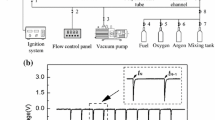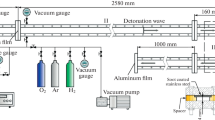Abstract
This experimental work investigates the possibility to non-dimensionalize the limits and the distances of the deflagration-to-detonation transition process (DDT). The deflagration was ignited using jets of hot gases generated by the impact of a Chapman–Jouguet detonation on a multi-perforated plate. The tube was 1 m long with a square cross section \(40\times 40\) mm\(^2\). The reactive mixtures were the stoichiometric compositions of hydrogen, methane, and oxygen (\(1-x\))\(\hbox {H}_2 + x\hbox {CH}_4 + 1/2(1 + 3x)\hbox {O}_2\) with the composition parameter x ranging from 0 to 1. The initial pressure \(p_0\) was varied from 12 to 35 kPa, and the initial temperature was 294 K. The widths of the detonation cells and the conditions and distances for DDT were obtained as functions of x, \(p_0\), the thickness of the plate, and the number and diameter of its perforations. The cell width was used as the reference length. The non-dimensional DDT distances correlate well with the non-dimensional number representing the surface re-ignition effect in the form of a concave increasing function. The non-dimensional DDT limits appear to be independent of the surface dissipation phenomena in the perforations. These trends are found to be independent of the regularity of the detonation cells. DDT processes are very dependent on the system configuration and the ignition conditions, but our analysis suggests that the proper selection of non-dimensional numbers based on the system characteristics can predict the DDT limits and distances to a reasonable approximation.












Similar content being viewed by others
Availability of data and materials
The data that support the findings of this study are available from the corresponding author upon reasonable request.
References
Ciccarelli, G., Dorofeev, S.: Flame acceleration and transition to detonation in ducts. Prog. Energy Combust. Sci. 34, 499–550 (2008). https://doi.org/10.1016/j.pecs.2007.11.002
Kuznetsov, M.S., Matsukov, I., Alekseev, V.I., Breitung, W., Dorofeev S.: Effect of boundary layer on flame acceleration and DDT. CDROM. 20th International Colloquium on the Dynamics of Explosions and Reactive Systems, Montreal (2005)
Kuznetsov, M.S., Alekseev, V.I., Matsukov, I.: DDT in a smooth tube filled with a hydrogen-oxygen mixture. Shock Waves 14, 205–215 (2005). https://doi.org/10.1007/s00193-005-0265-6
Yanez, J., Kuznetsov, M.S.: Experimental study and theoretical analysis of a ‘strange wave’. Combust. Flame. 167, 494–496 (2016). https://doi.org/10.1016/j.combustflame.2016.02.004
Ssu, H.W., Wu, M.H.: Fomation and characterisation of composite reaction-shock clusters in narrow channels. Proc. Combust. Inst. 38, 3473–3480 (2021). https://doi.org/10.1016/j.proci.2020.07.069
Ballossier, Y., Virot, F., Melguizo-Gavilanes, J.: Strange wave formation and detonation onset in narrow channels. J. Loss Prev. Process Ind. 72, 104535 (2021). https://doi.org/10.1016/j.jlp.2021.104535
Ballossier, Y., Virot, F., Melguizo-Gavilanes, J.: Flame propagation and acceleration in narrow channels: sensitivity to facility specific parameters. Shock Waves 31, 307–321 (2021). https://doi.org/10.1007/s00193-021-01015-9
Ali Cherif, M., Shcherbanev, S., Starikovskaia, S., Vidal, P.: Effect of non-equilibrium plasma on decreasing the detonation cell size. Combust. Flame. 217, 1–3 (2021). https://doi.org/10.1016/j.combustflame.2020.03.014
Short, M., Sharpe, G.J.: Pulsating instability of detonation with a two-step chain-branching reaction model: theory and numerics. Combust. Theory Model. 7, 401–416 (2013). https://doi.org/10.1088/1364-7830/7/2/311
Radulescu, M.I., Sharpe, G.J., Bradley, D.: A universal parameter quantifying hazards, detonability and hot spot formation: the \(\chi \) number. Proceedings of the Seventh International Seminar on Fire and Explosion Hazards, Singapore (2013)
Chao, J.: Critical deflagration waves that lead to the onset of detonation. PhD Thesis, McGill University. Montreal, DC, Canada (2006)
Radulescu, M.I., Sharpe, G.J., Lee, J.H.J., Kiyanda, C.B., Higgins, A.J., Hanson, R.K.: The ignition mechanism in irregular structure gaseous detonations. Proc. Combust. Inst. 30, 1859–1867 (2005)
Kuznetsov, M.S., Alekseev, V.I., Dorofeev, S.B.: Comparison of critical conditions for DDT in regular and irregular cellular detonation systems. Shock Waves 10, 217–223 (2000). https://doi.org/10.1007/s001930050009
Maley, L., Bhattacharjee, R., Lau-Chapdelaine, S.M., Radulescu, M.I.: Influence of hydrodynamic instabilities on the propagation mechanism of fast flames. Proc. Combust. Inst. 35, 2117–2126 (2015)
Obara, T., Sentanuhady, J., Tsukada, Y., Ohyagi, S.: Reignition process of detonation wave behind a slit-plate. Shock Waves 18, 63–83 (2008). https://doi.org/10.1007/s00193-008-0147-9
Bhattacharjee, R.R., Lau-Chapdelaine, S.S.M., Maines, G., Maley, L., Radulescu, M.I.: Detonation re-initiation mechanism following the Mach reflection of a quenched detonation. Proc. Combust. Inst. 34, 1893–1901 (2013)
Ciccarelli, G., Boccio, J.L.: Detonation wave propagation through a single orifice plate ina circular tube. Twenty-Seventh Symposium (International) on Combustion, 2233–2239 (1998)
Zhang, Z., Wang, C., Luo, X., Guo, Y., Rui, S., Guo, W.: Effect of perforated plate with high blockage rate on detonation re-initiation in H2–O2–Ar mixture. Int. J. Hydrog. Energy. 46(42), 2208–2222 (2021). https://doi.org/10.1016/j.ijhydene.2021.04.025
Medvedev, S.P., Khomik, S.V., Olivier, H., Polenov, A.N., Bartenev, A.M., Gelfand, B.E.: Hydrogen detonation and fast deflagration triggered by turbulent jet of combustion products. Shock Waves 14, 193–203 (2005). https://doi.org/10.1007/s00193-005-0264-7
Sentanuhady, J., Tsukada, Y., Yoshihashi, T., Obara, T., Ohyagi, S.: Re-initiation of detonation waves behind a perforated plate. 20th International Colloquium on the Dynamics of Explosion and Reactive Systems, vol. 20, Montreal, pp. 1–4 (2005)
Grondin, J.S., Lee, J.H.S.: Experimental observation of the onset of detonation downstream of a perforated plate. Shock Waves 20, 381–386 (2010). https://doi.org/10.1007/s00193-010-0267-x
Khomik, S.V., Veyssiere, B., Medvedev, S.P., Montassier, V., Olivier, V.: Limits and mechanism of detonation re-initiation behind a multi-orifice plate. Shock Waves 22, 199–205 (2012). https://doi.org/10.1007/s00193-012-0358-y
Khomik, S.V., Veyssiere, B., Medvedev, S.P., Montassier, V., Agafonov, G.L., Silnikov, M.V.: On some conditions for detonation initiation downstream of a perforated plate. Shock Waves 23, 207–211 (2013). https://doi.org/10.1007/s00193-012-0409-4
Khomik, S.V., Medvedev, S.P., Veyssiere, B., Olivier, H., Maksimova, O.G., Silkikov, M.V.: Initiation and suppression of explosive processes in hydrogen-containing mixtures by means of permeable barriers. Russ. Chem. Bull. 63, 1666–1676 (2014). https://doi.org/10.1007/s11172-014-0652-1
Manzhalei, V.I., Mitrofanov, V.V., Subbotin, V.A.: Measurement of inhomogeneities of a detonation front in gas mixtures at elevated pressures. Combust. Explos. Shock Waves 10, 89–95 (1974). https://doi.org/10.1007/BF01463793
Strehlow, R.: Investigation of the structure of detonation waves in gases. Astronautica Acta. 15, 345–357 (1970)
Monnier, V., Rodriguez, V., Vidal, P., Zitoun, R.: Experimental analysis of cellular detonations: regularity and 3D patterns depending on the geometry of the confinement. Extended Abstract Accepted for Oral Presentation to the 28th International Colloquium on the Dynamics of Explosion and Reactive Systems, Napoli (2022)
Monnier, V., Rodriguez, V., Vidal, P., Zitoun, R.: An analysis of three-dimensional patterns of experimental detonation cells. Submitted to Combustion and Flame (2022)
Acknowledgements
This work was supported by a CPER-FEDER Project of Région Nouvelle Aquitaine and the French National Agency (ANR) under the project ANR-21-CE05-0002-01.
Author information
Authors and Affiliations
Corresponding author
Additional information
Communicated by G. Ciccarelli.
Publisher's Note
Springer Nature remains neutral with regard to jurisdictional claims in published maps and institutional affiliations.
Rights and permissions
About this article
Cite this article
Rodriguez, V., Monnier, V., Vidal, P. et al. Non-dimensionalized distances and limits for the transition of deflagration to detonation. Shock Waves 32, 417–425 (2022). https://doi.org/10.1007/s00193-022-01088-0
Received:
Revised:
Accepted:
Published:
Issue Date:
DOI: https://doi.org/10.1007/s00193-022-01088-0




